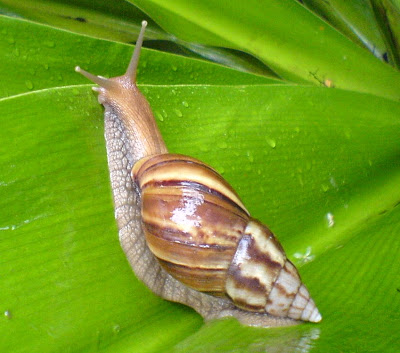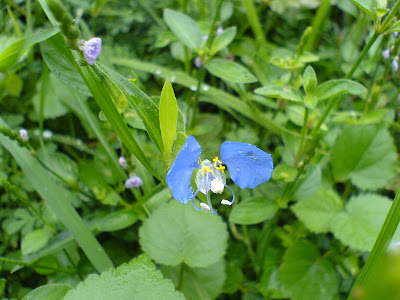A weekend with trees
17th July 2010:
Off to Nanmangalam extension centre as a Nizhal volunteer. Its been cloudy and rainy in general, but of course on 17th July its blazing hot.
The plan is to take a bunch of 60(!) high school kids around the extension centre, talk to them about trees and their importance, introduce them to native species (as against our familiar exotics like Rain Tree and Gulmohar), and hope to sensitise future citizens against indiscriminate tree cutting and to promote wise tree planting as well.
Usha takes her car, and we trundle along past Pallikaranai and Quaidemillat college, and hear blaring music from a temple loudspeaker. Its supposed to be devotional, but how anyone could feel devotional under this auditory assault is beyond me. Maybe its me that is so lacking in faith?
Anyway, if you think I am digressing I am not. Deepika said that as soon as we hear the music we were to do a U-turn and we would arrive at the extension centre gates! It was a very accurate landmark that no GPS system could have given!
Mr Ashokan the DCF turned out to be enthusiastic and committed, and so the walk was a breeze. The kids arrived with no caps and large heavy bags (should remedy this for the next school visit), but were attentive and interested.
The Extension Centre abuts the road, and there is active tree planting of indigenous species going on here. There were two views on the setting up of this centre but it seems to be here to stay.
The trees below are those planted in the extension area. Interestingly, all these native trees are high on medicinal properties. Its imperative that we research them and obtain patents.
 Terminalia arjuna - fruiting
Terminalia arjuna - fruiting Called Neer marudhu in Tamil, the Arjun tree grows all over India, and is widely used in ayurveda for a whole host of cures. The bark and leaves seem to be helful in treating heart conditions.
 Morinda citrifolia-Nuna
Morinda citrifolia-Nuna
 Morinda citrifolia-Nuna
Morinda citrifolia-NunaAnother wonder tree is nuna. The fruit you see is used to make juice that is rich in vitamins and minerals.
I stared idly at this tree. Not particularly distinguished, but it has these opposing names - Devil's tree on the one hand, and scholar's tree on the other. So our all scholars devils or are all devils scholars?!
For some reason, tribals in the Western Ghats reportedly dont like to sit under this tree as the devil is believed to live in it. Its bark is used to treat loosies, and its wood was traditionally used to make blackboards - hence the scholaris title.
 Callophyllum inophyllum - Alexandrian Laurel - punnai
Callophyllum inophyllum - Alexandrian Laurel - punnai
 Callophyllum inophyllum - Alexandrian Laurel - punnai
Callophyllum inophyllum - Alexandrian Laurel - punnaiA coastal tree, very decorative, and Usha says they are lining the streets in Pondy. I should check next time we go there. And guess what, that fruit you see is quite magical. An oil extracted from its nut is used in anti-ageing creams, and is also a viable biodiesel!!
We saw herbs that help in dandruff control, Vitex negundo (nochi) that is like a backyard mosquito control plant, sandalwood saplings, Indian rosewood and mahogany and so much more.
Next week we go back for a nature walk through the RF, with the same kids.
July 18th:
6:45 am, nagging drizzle, overcast skies. This could have been yesterday's weather, but no, I want sun I get rain, and vice versa! And why did I want sun? So the butterflies would be out, and the birds would be chirping as we took the young children of the Madras Club on a little walk around the club.
Sudhakar and Minni kindly agreed to come in as the experts, and we did stroll around the club grounds, heartened by the enthusiasm of the children. Thankfully trees stay where they are, and so we used them as the anchors for our walk!
The lovely banyan, the spreading rain trees, fish-tail palms, the massive neem on the lawns and the plentiful copper pods provided talking points.
As did this Gastropod.
Check out the muscular foot that the snail uses to move along, by its contractions. 1mm/second average snail speed.
Isn't that a beautiful glistening shell?
Sudhakar pointed out the day flowers in the green lawns underfoot. Click on the picture and see the flower zoomed in, its rather lovely, delicate and intricate, all for a day.
But this tree below was unidentified
 Tree unknown (Identified as Mimusops elengi - Magizham)
Tree unknown (Identified as Mimusops elengi - Magizham) Plumeria obtusa - Singapore frangipani
Plumeria obtusa - Singapore frangipani
 Tree unknown (Identified as Mimusops elengi - Magizham)
Tree unknown (Identified as Mimusops elengi - Magizham) Plumeria obtusa - Singapore frangipani
Plumeria obtusa - Singapore frangipani
The flowers of this plumeria are different from the common one, rather more elegant I thought.
And so we wound up, after more earthworms, cotton stainer bugs, seven spotted cockroaches, millipedes, centipedes and a red bead tree.
We were rewarded by a sumptuous breakfast that included "mla pesarattu" - also a first time for me!!

 The huge snail that caught all the oohs and aahs
The huge snail that caught all the oohs and aahs Commelina - day flowers
Commelina - day flowers

So interesting, as always, Ambika, and breathtaking pictures. Great job taking school kids around and teaching them about trees and their importance. Wish we could teach adults not to 'noise pollute'.
ReplyDeleteGood one! and what a nice idea to take kids on a tree walk! wish someone would do that here... must moot the idea with some nature lovers here... and the snail is really beautiful! we see so many of those here outside our house, but the pics dont come out that well....of course, it doesnt stop me clicking away every time i see one of them!
ReplyDeleteAnu, Gardenia, yes I like going around with school kids, because I learn a lot, and also they dont know how little I know!!
ReplyDeleteHere's some additional information from Chitre, via email:
"I think (from the picture posted) the gastropod - snail that you waxed eloquent is an invasive snail from Africa (Achatina fulica, Giant African Land Snail) that seems to be the scourge of all other native snails and even some local flora. It was introduced sometime in the 50s by someone (not sure who and for what reason) but its turning out to be a pain in the environment! It was also introduced with disastrous results in Hawaii where many of their endemic snails are close to extinction thanks to this."
Sorry "Chitra", nnot "Chitre"!
ReplyDeleteHi there. I happened to chance on your blog, having grown up in Channi, and being a plant enthusiast myself. I could be wrong, but the unidentified tree looks like a Diospyros (persimmon family). I'm not sure of the exact species. Perhaps it is Diospyros kaki. Hope this helps.
ReplyDeleteCheers,
Juggi Ramakrishnan
Juggi Ramakrishnan, thanks for the tip! I just checked it out on the net, and it is a possibility! I will keep an eye out for the flowers of the tree too!
ReplyDeleteMany thanks!
the unknow tree name is mimpus elengi or mazhilampoo maram in tamil.
ReplyDeleteMimusops elengi botonical name and magilampoo maram in tamil
ReplyDeleteIt's inspiring to see how nature can provide a perfect escape from the hustle and bustle of daily life.
ReplyDelete